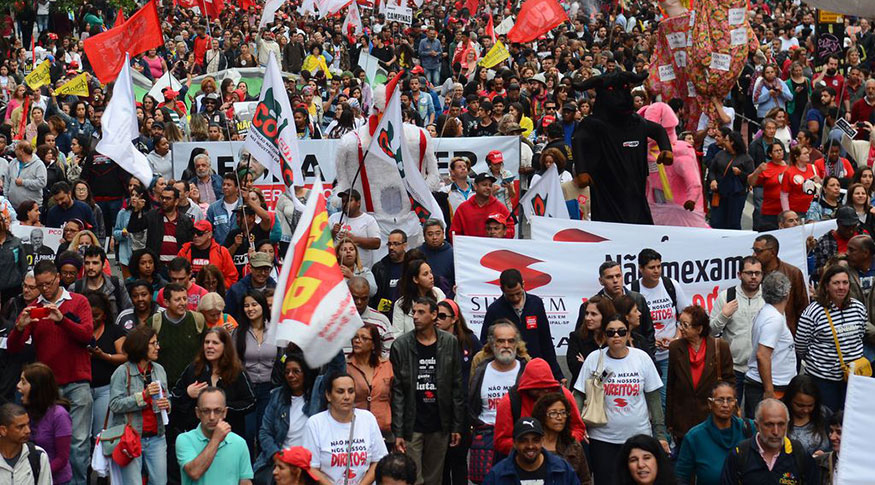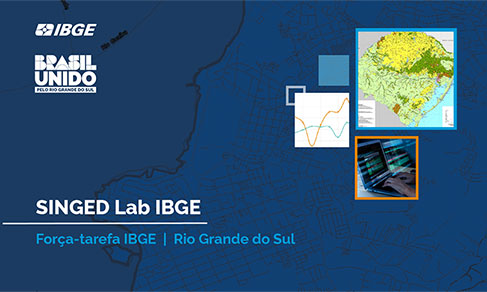Labor Market
Unionization rate falls to 9.2% in 2022, the lowest rate of the series
September 15, 2023 10h00 AM | Last Updated: September 19, 2023 10h51 AM
Highlights
- In 2022, of the 99.6 million employed persons in the country, 9.2% (or 9.1 million persons) were members of a union.
- This was the smallest number in the series that began in 2012, when there were 14.4 million unionized workers (16.1%). In 2019, this rate was 11.0% (10.5 million).
- In the same period, the employed population reached its highest number: 99.6 million persons, an increase of 4.9% compared to 2019 (95.0 million) and 11.0% compared to 2012 (89.7 million).
- All Major Regions had a reduction in the unionization rate in 2022. Compared to 2012, the biggest drop was in the South (9.2 pp) and compared to 2019, in the Southeast (2.4 pp).
- Except for Domestic Services, the unionization rate fell in all groups of activities, both in relation to 2019 and 2012. The biggest drop was in Transportation, storage and mailing services: from 20.7% in 2012 to 11.8% in 2019 and 8.2% in 2022.
- Workers with a formal contract in the private sector and those employed in the public sector, which had the highest unionization rates (respectively, 11% and 19.9%), recorded the main losses: 2.9 pp and 2.2 pp, respectively, compared to 2019 and 9.9 pp and 8.1 pp compared to 2012.
- Among the 30.2 million employers and self-employed workers in the country, 10.3 million (or 34.2%) were in enterprises registered with the National Register of Legal Entities (CNPJ), an increase compared to 2019 (29.3%).
- Compared to 2019, CNPJ coverage grew among self-employed workers (from 20.2% to 26.3%) and remained practically stable (from 80.5% to 80.9%) among employers.
- Of the total number of employers or self-employed persons in the main job, 5.3% (1.6 million persons) were members of a worker's or producuer's cooperative.
 In 2022, less than 10% of workers were unionized, reaching the lowest number in the series started in 2012 - Photo: Rovena Rosa/Agência Brasil
In 2022, less than 10% of workers were unionized, reaching the lowest number in the series started in 2012 - Photo: Rovena Rosa/Agência BrasilIn 2022, of the 99.6 million employed persons, 9.2% (9.1 million persons) were members of a union. This is the smallest amount in the series that began in 2012, when there were 14.4 million unionized workers (16.1%). In 2019, this rate was 11.0% (10.5 million). The figures are from the module: 2022 Additional Characteristics of Labor Market, of the Continuous National Household Sample Survey (PNAD).
All major regions saw a reduction in union members in 2022. The South (11.0%) recorded the highest rate, followed by the Northeast (10.8%), Southeast (8.3%), North (7.7%) and Midwest (7.6%). In relation to 2012, the biggest drop was recorded by the South region (9.2 p.p.) and, in relation to 2019, the biggest drop occurred in the Southeast (2.4 p.p.), which for the first time had a rate below 10 %.
“The reduction in the unionized population became sharper from 2016 onwards, when the drop in union membership was accompanied by a decline in the total employed population. As of 2017, despite the growing employed population, the number of unionized workers continued to fall”, analyzes Adriana Beringuy, coordinator of household sample surveys at IBGE.
In 2022, the employed population reached its highest estimate, 99.6 million persons. This contingent represented an increase of 4.9% compared to 2019 (95.0 million persons) and 11.0% compared to the 2012 population (89.7 million persons).
However, “the expansion of the employed population in recent years has not resulted in an increase in union coverage. This may be related to several elements, such as the deepening of more flexible contractual modalities introduced by the 2017 Labor Reform, independent forms of insertion of workers in production as an alternative to collective organization, and the increase of temporary contracts in the public sector”, highlights the coordinator.
The Additional Characteristics of the Labor Market module is investigated in the first visits to the households in the Continuous Pnad sample. Due to the Covid-19 pandemic, data from 2020 and 2021 were not released. The coordinator also clarifies that the first visits by the survey schedule occur during every month of the year and thus capture the seasonality of the job market throughout of the year.
Transportation, storage and mailing have the biggest drop in unionization rate
The unionization rate fell in all groups of activities, both in relation to 2019 and 2012. The exception was Domestic services, which maintained the 2.8% recorded in 2019 and grew 0.1 pp compared to 2012 (2.7% ), but always with the lowest rate among the groups.
The biggest drop was in the Transportation, storage and mailing activity, which in 11 years registered a reduction of 12.5 pp, from 20.7% in 2012 to 11.8% in 2019 and 8.2% in 2022.
“In recent years, the growth of employment in this activity has been fostered by land passenger transportation, gathering together many workers (drivers) with isolated and informal insertion in employment, which can contribute to the drop in unionization”, declares the coordinator.
The highest unionization rate was in Agriculture, livestock, forestry, fishing and aquaculture (16.5%). “This activity has important participation from rural workers' unions, through which many family farming workers seek assistance and information about the organization of their production, especially in the Northeast Region”, explains Ms. Beringuy.
Also with important union coverage, Public administration, defense and social security, education, human health and social services (15.8%) continued to decline in 2022. The same movement was demonstrated by General Industry, which until 2015 had shown a unionization rate close to 20%, lowering the estimate to 11.5% in 2022.
Although Trade, repair of motor vehicles and motorcycles is responsible for around 19.1% of the total employed population, this activity recorded a unionization rate of 5.6%, lower than the average observed for the total employed population (9.2%). “In this sense, it is observed that union coverage does not depend on the number of workers in a given economic activity, but also on how workers organize themselves and are involved in production and the role of unions in labor relations”, notes Ms. Beringuy.
Less than 20% of public sector workers are unionized
Workers with a formal contract in the private sector and those employed in the public sector (including statutory and military servants) had the highest unionization rates, respectively, 11% and 19.9%. But these two categories recorded the main losses in the periods analyzed, of 2.9 pp and 2.2 pp, respectively, compared to 2019 and 9.9 pp and 8.1 pp in relation to 2012.
“These groups are those that historically have the highest percentages of membership. The drop shows that regardless of the sector of activity, public or private, the decline in unionization in Brazil is advancing in all employment segments” concludes Ms. Beringuy.
Also noteworthy are the falls in the employer category, which went from 18.4% in 2012 to 10.2% in 2019 and 8.2% in 2022, and in the self-employed category, which went from 11.1% in 2012 to 7 .1% in 2019 and 6.2% in 2022.
Workers in the private sector without a formal employment contract (3.5%) and domestic workers (2.8%) recorded the lowest coverage. “In the case of contributing family workers (10.3%), the comparatively high percentage can be explained by the concentration of these workers in family-based agricultural activities, with significant participation of rural workers unions”, he comments.
Number of self-employed workers and employers with CNPJ grows compared to 2019
In 2022, of the 30.2 million self-employed persons and employers, 10.3 million (34.2%) were in enterprises registered with the National Register of Legal Entities – CNPJ, an increase compared to 2019 (29.3%).
Regionally, the North (15.1%) and Northeast (20%) had the lowest proportions, and the South (46.3%) and Southeast (41.4%) the highest. The Central-West (38.6%) stood out with the biggest increase, both in relation to 2012 (11.3 pp) and 2019 (8.4 pp)
Employers and self-employed workers were mainly concentrated in Trade and Services activities, with estimates of 22.4% and 41.3%, respectively. These two activities also had the highest CNPJ coverage rates, at 49.0% and 39.6%, respectively. It is also worth highlighting that General Industry, which accounted for only 8.8% of these employed persons, had the third highest CNPJ coverage rate (32.2%). With lower values were Agriculture, livestock, forestry production, fishing and aquaculture (10.1%) and Construction (19.3%).
Compared to 2019, all groups showed an expansion in CNPJ coverage. The main increase occurred in Trade, repair of motor vehicles and motorcycles (from 43% to 49%). Compared to 2012, the number of registered workers had strong expansion in Construction (216%, reaching 791 thousand persons) and in Services (114%, taking its population to 4.9 million persons).
CNPJ coverage grows among the self-employed, but employers maintain stability
In 2022, of the 25.8 million self-employed persons, 26.3% (6.8 million) were registered with the CNPJ; while among the 4.4 million employers, coverage reached 80.9% (3.5 million). While CNPJ coverage among self-employed workers grew from 20.2% to 26.3% compared to 2019, that of employers remained practically stable (from 80.5% to 80.9%).
Among self-employed workers, Construction and Services showed the biggest increases in CNPJ coverage, both in relation to 2012 and 2019. In Construction, coverage went from 3.9% in 2012 to 9.9% in 2019 and reaching 14.8% in 2022. In Services, the rate went from 21.3% in 2012 to 25.1% in 2019 and 33.0% in 2022. Among employers, the advance in Construction stands out, which went from 36.1% in 2012 to 54.1% in 2019 and 62.9% in 2022.
South Region has the highest proportion of workers associated with cooperatives
Of the total number of employers or self-employed persons in their main job, 5.3% (1.6 million persons) were members of a worker cooperative, which shows the low adherence of workers to this type of productive arrangement in Brazil. The highest proportion occurred in 2012 (6.3%) and, since 2015, it has been decreasing to reach the lowest value in 2019 (5.1%). In 2022 this proportion was 5.3%. The South Region (9.1%) has the highest percentage, followed by the North (5.5%); Northeast (4.6%), Southeast (4.5%) and Central-West (3.8%).




















